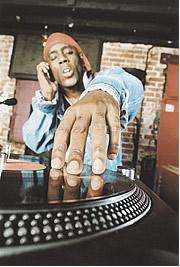 The rap world is well connected by collaborations.© Getty
The rap world is well connected by collaborations.© GettyThe rivalry and feuds for which rap music is notorious may mean that in contrast to other human social networks, like does not attract like.
All the same, says Reginald Smith of the Sloan School of Management at the Massachusetts Institute of Technology, the rap world is not an unfriendly place. As with other human networks, collaborations between rappers bring them together into their own small community. On average, any two artists chosen at random can be linked by a chain of collaborations involving three other people - in other words, they are connected by three degrees of separation1.
Smith says that rap music is particularly noted for its collaborative nature; many solo performers or members of rap groups make guest appearances on each other's recordings. In this respect, rap exhibits the same spirit as early jazz, where musicians had on average less than two degrees of separation2.
“Tryin' to spread a lil' unity between you and me.”
Snoop Dogg
Smith has mapped out the network of the rapping community by processing data from online rap and hip-hop archives. 'Cleaning' all this data, muddied by misspellings and numerous pseudonyms, to extract a reliable network containing 6,552 rappers and over 30,000 songs was "an extremely tedious process", Smith admits.
He finds that on average it takes a chain of just 2.9 people in the network to connect one rapper to another; that is, three degrees of separation. This compares with 2.5 people for the network of movie actors (popularized in the Kevin Bacon game ), 3.6 for company board directors3, and 5.9 for collaborations between high-energy physicists4.
An eclectic mix
Where the rap network differs from these others, however, is in a property called assortativity. This is a measure of how mixed the collaborations are between highly connected and less connected people. In assortative networks, well-connected individuals tend to prefer to make links with others similar to themselves. "This is a pattern we've seen in most social networks", says Mark Newman, a physicist at the University of Michigan who has studied scientific collaboration networks.
There seems to be no such pattern for rappers. Smith suggests that this might be partly due to commercial competition between successful artists, who are reluctant to lend their cachet to a rival.
But he points out that the aversions of successful rap artists may go deeper than that. Feuds are common in the business, such as that which existed in the mid-1990s between artists signed to Death Row Records in Los Angeles and those with Bad Boy Records in New York. Such rivalries have sometimes led to violence and even murder.
ADVERTISEMENT
There are more benign interpretations, however. "Perhaps the luminaries are helping beginners to find their feet", Newman suggests.
He also cautions that such an apparent lack of interaction between well-connected individuals can also arise if the data on the collaborations of peripheral members of the network are unreliable. That has been seen to skew the figures for networks of sexual contacts, which are studied to try to understand the spread of sexually transmitted diseases.
And who is the most highly connected rapper? It's Snoop Dogg, naturally, who seems to have justified the title of his 1999 album No Limit Top Dogg.
-
References
- Smith R. D. . , Preprint available at http://xxx.arxiv.org/abs/physics/0511215 (2005).
- Gleiser P. M., Danon L.. Preprint available at http://xxx.arxiv.org/abs/cond-mat/0307434 (2003).
- Newman M. E. J., et al. Phys. Rev., E64. 026118 (2001).
- Newman, M. E. J., et al. Natl Acad. Sci. USA, 98. 404 - 409 (2001).
